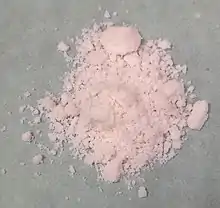Erbium(III) acetate
Erbium(III) acetate is the acetate salt of erbium, with the proposed chemical formula of Er(CH3COO)3. It can be used to synthesize some optical materials.[2]
 | |
| Names | |
|---|---|
| Other names
Erbium acetate Erbium triacetate | |
| Identifiers | |
3D model (JSmol) |
|
| ChemSpider | |
| ECHA InfoCard | 100.042.774 |
| EC Number |
|
PubChem CID |
|
CompTox Dashboard (EPA) |
|
| |
| |
| Properties | |
| Er(CH3COO)3 | |
| Appearance | light red solid |
| soluble | |
| Hazards | |
| GHS labelling:[1] | |
 | |
| Warning | |
| H315, H319, H335 | |
| P261, P264, P264+P265, P271, P280, P302+P352, P304+P340, P305+P351+P338, P319, P321, P332+P317, P337+P317, P362+P364, P403+P233, P405, P501 | |
| Related compounds | |
Other cations |
Holmium(III) acetate Thulium(III) acetate |
Related compounds |
Erbium oxide |
Except where otherwise noted, data are given for materials in their standard state (at 25 °C [77 °F], 100 kPa).
Infobox references | |
Physical properties
The tetrahydrate of erbium(III) acetate is thermally decomposed at 90 °C, giving a proposed anhydride:
- Er(CH3COO)3·4H2O → Er(CH3COO)3 + 4 H2O
Continued heating to 310 °C will form ketene:
- Er(CH3COO)3 → Er(OH)(CH3COO)2 + CH2=C=O
At 350 °C, the proposed Er(OH)(CH3COO)2 loses acetic acid to yield a material of the formula ErOCH3COO, forming Er2O2CO3 at 390 °C, finally obtaining Er2O3 at 590 °C.[3]
References
- "Erbium(3+) acetate". pubchem.ncbi.nlm.nih.gov. Retrieved 22 July 2022.
- Choi, M. H., & Ma, T. Y. (2008). Erbium concentration effects on the structural and photoluminescence properties of ZnO: Er films. Materials Letters, 62(12-13), 1835-1838.
- G. A. M. Hussein (2001-08-28). "Erbium oxide from erbium acetate hydrate; formation, characterization and catalytic activity". Powder Technology. 118 (3): 285–290. doi:10.1016/S0032-5910(00)00384-3. ISSN 0032-5910. Retrieved 2019-02-01.
This article is issued from Wikipedia. The text is licensed under Creative Commons - Attribution - Sharealike. Additional terms may apply for the media files.